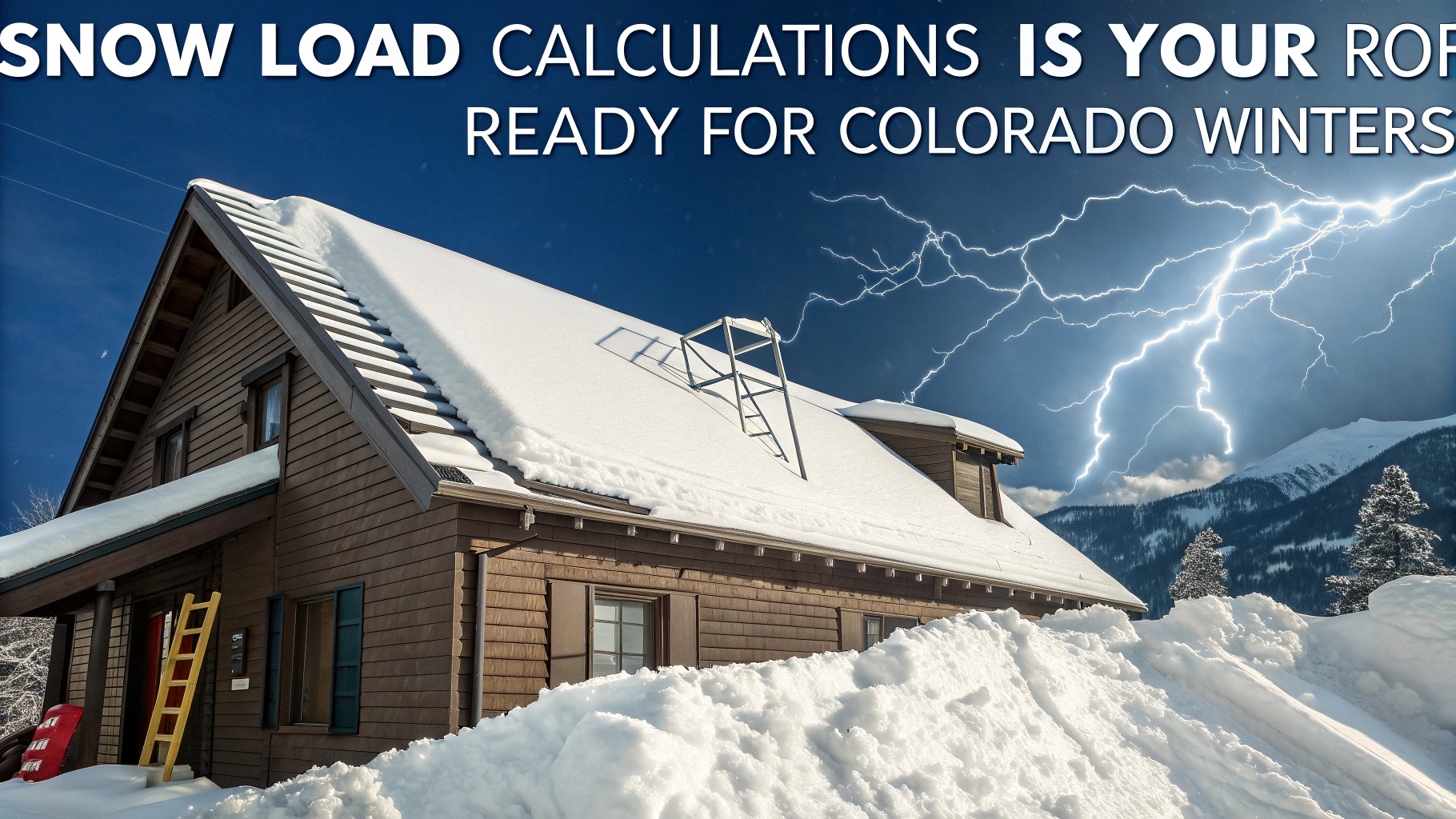Colorado’s winter snow loads can put immense pressure on residential and commercial roofs, making proper calculations and preparations essential for structural safety.
Understanding your roof’s snow load capacity helps prevent costly damage and ensures your building remains protected during heavy snowfall events.
This guide explains how to calculate snow loads, identify warning signs, and take preventive measures to protect your Colorado property.
Understanding Snow Load Basics
Snow load refers to the weight of accumulated snow and ice that a roof must safely support.
- Ground Snow Load: 30-400 pounds per square foot (varies by Colorado location)
- Roof Snow Load: Usually 20-30% less than ground load due to wind and slope factors
- Design Load: The maximum weight your roof was engineered to handle
Colorado Snow Load Requirements by Region
| Region | Ground Snow Load (psf) |
|---|---|
| Denver Metro | 30-35 |
| Colorado Springs | 30-40 |
| Mountain Communities | 100-400 |
| Western Slope | 40-75 |
Warning Signs of Excessive Snow Load
- Sagging roof deck or ceiling
- Cracking or popping sounds
- Doors or windows that stick
- Visible cracks in walls or masonry
- Leaking or water stains
Calculating Your Roof’s Snow Load
Use this simple formula: Ground Snow Load × 0.7 (slope/exposure factor) = Roof Snow Load.
Factors Affecting Snow Load:
- Roof pitch and design
- Building exposure to wind
- Elevation and location
- Nearby structures affecting snow drift
Professional Snow Load Assessment
Contact a licensed structural engineer for accurate calculations specific to your property.
Local Resources:
- Colorado Association of Structural Engineers: www.costructuralengineers.org
- Building Department Contacts: Colorado Building Codes
Preventive Measures
- Schedule annual roof inspections before winter
- Install snow guards to prevent avalanche effects
- Ensure proper attic insulation and ventilation
- Clear gutters and drainage systems
- Consider snow removal service contracts
Safe Snow Removal Methods
Never attempt to remove snow from the roof yourself – contact professional snow removal services.
Recommended Equipment:
- Roof rakes (for single-story buildings only)
- Safety harnesses and proper tie-offs
- Non-metallic shovels to prevent roof damage
Preparing Your Roof for Winter
Contact a licensed Colorado roofing contractor for a pre-winter inspection.
For emergency snow removal or roof inspections, call:
- Colorado Roofing Association: 303-484-0549
- Emergency Services: 911 for immediate structural concerns
Insurance and Documentation
Document your roof’s condition and maintenance history to support potential insurance claims.
- Take dated photographs of your roof seasonally
- Keep maintenance and inspection records
- Review insurance coverage for snow damage
- Understand policy requirements for snow removal
Emergency Response Planning
Create an action plan for heavy snowfall events to protect your property and occupants.
Essential Steps:
- Identify warning signs of structural stress
- Keep emergency contact numbers accessible
- Establish evacuation procedures if needed
- Maintain emergency supplies and equipment
Protecting Your Investment Year-Round
A proactive approach to roof maintenance and snow load management helps ensure your property’s longevity and safety in Colorado’s challenging climate.
- Schedule bi-annual professional inspections
- Address repairs promptly to prevent winter complications
- Monitor weather forecasts and snow accumulation
- Maintain relationships with reliable contractors
Securing Your Property’s Winter Safety
Understanding and managing snow loads is crucial for Colorado property owners. Regular maintenance, professional assessments, and prompt response to warning signs will help protect your investment and ensure occupant safety throughout the winter season.
Remember to consult local building codes and professional engineers for specific requirements in your area, and never hesitate to seek expert assistance when concerns arise.
FAQs
- What is the average snow load capacity for residential roofs in Colorado?
Most residential roofs in Colorado are designed to support 30-40 pounds per square foot of snow load, though requirements vary by elevation and location within the state. - How can I calculate the snow load on my roof?
Multiply the depth of snow in feet by its density (typically 10-12 pounds per cubic foot for fresh snow, 20-40 for packed snow) and the square footage of your roof’s surface area. - What signs indicate my roof is struggling with snow load?
Common signs include sagging roof lines, cracking or creaking sounds, difficult-to-open doors or windows, and visible cracks in walls or ceiling drywall. - How often should I remove snow from my Colorado roof?
Snow should be removed when accumulation exceeds 12 inches or when the calculated weight approaches your roof’s load capacity, especially after multiple storms without melting. - Do different roof pitches affect snow load capacity?
Yes, steeper pitches (6:12 or greater) typically handle snow loads better as they allow more snow to slide off naturally, while flatter roofs require higher load capacity ratings. - What role does elevation play in Colorado snow load requirements?
Higher elevations require greater snow load capacity. For example, homes above 6,000 feet often need 40-60 pounds per square foot capacity versus 30-40 at lower elevations. - How do different roofing materials handle Colorado snow loads?
Metal roofs typically shed snow more effectively than asphalt shingles, while slate and tile roofs require additional structural support due to their inherent weight plus snow load. - Are there specific building codes for snow loads in Colorado?
Yes, Colorado follows the International Building Code (IBC) with local amendments. Requirements vary by jurisdiction and are based on ground snow loads, elevation, and exposure factors. - How do I know if my roof needs structural reinforcement for snow loads?
An inspection by a licensed structural engineer can determine if your roof needs reinforcement, especially for homes built before current snow load codes or those showing signs of stress. - What impact do ice dams have on snow load concerns?
Ice dams increase effective snow load by preventing proper drainage and adding concentrated weight at roof edges, potentially exceeding designed load capacity.
